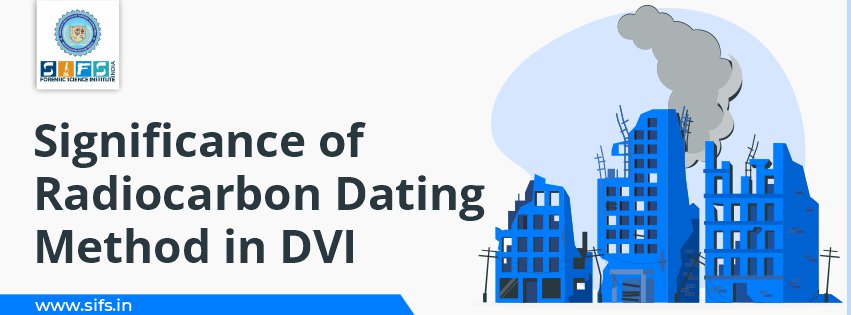- Call Us: +91 7303913002
- Email Us: education@sifs.in
Significance of Radiocarbon Dating Method in DVI

BY SIFS India | June 15, 2020
Significance of Radiocarbon Dating Method in DVI
Radiocarbon dating method or 14C method (commonly known as Carbon-14 dating method) is used for dating human remains since the late 1940s at the University of Chicago by William Libby.
Usually 14C is produced in upper atmosphere by the process where cosmic rays act on nitrogen (12N).
It is a radiometric decay method which uses the half-life of any radioactive isotope to determine how old the substance is.
Half-life of any object can be defined as the period of time it takes to attain half of the actual quantity it started with.
In traditional carbon dating methods, researchers identified that trace amount of radioactive matters are present in organic remains of 500-50,000 years of age but now these techniques are applicable in various research areas, disaster victim identification from tissue remains is one among them.
Radiocarbon Dating in Disaster Victim Identification (DVI)
Identification of deceased plays very important role in any case where his/her identity is unknown.
Disaster victim identification or DVI, is the method to identify victims of mass fatality events or other natural disasters like- tsunami, cyclone, earthquake, landslides, etc. as well as man-made incidences like transport accidents, nuclear explosion/nuclear radiation, terrorist attacks, etc. leads to potential deaths.
First Guide to Disaster Victim Identification was produced by INTERPOL in 1984, which is accepted globally as standard for DVI protocol.
It includes 4 stages to faultlessly identify victims:
- Crime scene examination
- Post-mortem data (like fingerprints, odontology, recording physical indications & DNA profiling)
- Ante-mortem data (for example, dental records, documents having thumb impressions, IDs, etc.)
- Reconciliation
Forensic Applications of 14C Dating Method
Although forensic scientists have been using several methods for the identification of disaster victims like forensic odontology, facial recognition, 3-D Facial reconstruction, etc., techniques like radiocarbon dating contribute more and more in forensic research fields.
This technique of measuring 14C level in human tissues could help forensic scientists to determine age and year of birth in cases involving unidentified human remains.
Study of the past 6 decades reveals that the amount of radiocarbon in any tissue or human remains depends on where and when they were born, or more precisely when their tissues were formed.
This is possible because of the reason that the production of 14C in the atmosphere has not been constant over time (due to fluctuation in the number of cosmic rays reaching to the earth).
Forensic Anthropologist at The University of Arizona found this fact as an advantage in a recent study to identify the year of birth or year of death using accurate measurement of radiocarbon level in human remains or various PM tissues.
They measured radiocarbon level in several tissues (especially focused on tooth enamel) from 36 humans whose birth and death dates were known.
Researchers found that if they assumed the radiocarbon level of tooth enamel, they could predict the year of birth by determining the atmospheric level at the time the tooth was formed.
Later they found that, unlike tooth enamel, soft tissues are constantly made or remade during life. Thus, their 14C level expresses those changes in the atmosphere, i.e. soft tissues like blood, hair, and nails could indicate the year.
They concluded that the year of death determinations based on the nails was precise within 3 years.
Besides the radiocarbon dating method that required a huge amount of samples, today researchers use AMS (Accelerator Mass Spectrometers) to count 14c atoms in a sample, and also, different methods are introduced to reduce the chances of sample contaminations to utilize this technique for human identification.
There is no one way to become a skilled anthropologist. There are several certificate, diploma, and degree level courses that you can enroll in.
However, if you want to gain industrial experience and be job-ready as soon as you complete your training, SIFS India offers several certificates, diplomas, post-graduate diploma courses. You can visit the course page to get complete training details or contact our expert if you have any doubt.
Also, we organize various knowledge base forensic events, workshops, and online conferences at regular intervals that you can participate in.

